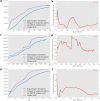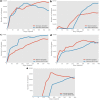A generalized simulation development approach for predicting refugee destinations
- PMID: 29042598
- PMCID: PMC5645318
- DOI: 10.1038/s41598-017-13828-9
A generalized simulation development approach for predicting refugee destinations
Abstract
In recent years, global forced displacement has reached record levels, with 22.5 million refugees worldwide. Forecasting refugee movements is important, as accurate predictions can help save refugee lives by allowing governments and NGOs to conduct a better informed allocation of humanitarian resources. Here, we propose a generalized simulation development approach to predict the destinations of refugee movements in conflict regions. In this approach, we synthesize data from UNHCR, ACLED and Bing Maps to construct agent-based simulations of refugee movements. We apply our approach to develop, run and validate refugee movement simulations set in three major African conflicts, estimating the distribution of incoming refugees across destination camps, given the expected total number of refugees in the conflict. Our simulations consistently predict more than 75% of the refugee destinations correctly after the first 12 days, and consistently outperform alternative naive forecasting techniques. Using our approach, we are also able to reproduce key trends in refugee arrival rates found in the UNHCR data.
Conflict of interest statement
The authors declare that they have no competing interests.
Figures






Similar articles
-
Neonatal mortality burden and trends in UNHCR refugee camps, 2006-2017: a retrospective analysis.BMC Public Health. 2021 Feb 22;21(1):390. doi: 10.1186/s12889-021-10343-5. BMC Public Health. 2021. PMID: 33618684 Free PMC article.
-
Utilization of outpatient services in refugee settlement health facilities: a comparison by age, gender, and refugee versus host national status.Confl Health. 2011 Sep 21;5:19. doi: 10.1186/1752-1505-5-19. Confl Health. 2011. PMID: 21936911 Free PMC article.
-
International refugees: a geographical perspective.J Geog. 1987 Sep-Oct;86(5):225-8. doi: 10.1080/00221348708979490. J Geog. 1987. PMID: 12178553
-
A review of the literature on sexual and reproductive health of African migrant and refugee children.Reprod Health. 2021 Apr 17;18(1):81. doi: 10.1186/s12978-021-01138-3. Reprod Health. 2021. PMID: 33865417 Free PMC article. Review.
-
Review of Humanitarian Guidelines to Ensure the Health and Well-being of Afghan Refugees on U.S. Military Bases.Mil Med. 2022 Oct 29;187(11-12):1299-1309. doi: 10.1093/milmed/usac086. Mil Med. 2022. PMID: 35383836 Review.
Cited by
-
Sensitivity-driven simulation development: a case study in forced migration.Philos Trans A Math Phys Eng Sci. 2021 May 17;379(2197):20200077. doi: 10.1098/rsta.2020.0077. Epub 2021 Mar 29. Philos Trans A Math Phys Eng Sci. 2021. PMID: 33775152 Free PMC article.
-
The potential of Facebook advertising data for understanding flows of people from Ukraine to the European Union.EPJ Data Sci. 2022;11(1):59. doi: 10.1140/epjds/s13688-022-00370-6. Epub 2022 Dec 6. EPJ Data Sci. 2022. PMID: 36530791 Free PMC article.
-
What we do know (and could know) about estimating population sizes of internally displaced people.J Migr Health. 2022 May 29;6:100120. doi: 10.1016/j.jmh.2022.100120. eCollection 2022. J Migr Health. 2022. PMID: 35694420 Free PMC article.
-
From digital hype to analogue reality: Universal simulation beyond the quantum and exascale eras.J Comput Sci. 2020 Oct;46:101093. doi: 10.1016/j.jocs.2020.101093. J Comput Sci. 2020. PMID: 33312270 Free PMC article.
-
An agent-based framework to study forced migration: A case study of Ukraine.PNAS Nexus. 2024 Mar 19;3(3):pgae080. doi: 10.1093/pnasnexus/pgae080. eCollection 2024 Mar. PNAS Nexus. 2024. PMID: 38505694 Free PMC article.
References
-
- UNHCR. Figures at a glance. United Nations High Commissioner for Refugees. Available at: http://www.unhcr.org/uk/figures-at-a-glance.html (2017).
-
- Lee ES. A theory of migration. Demography. 1966;3:471–486. doi: 10.2307/2060063. - DOI
-
- Moore WH, Shellman SM. Whither will they go? A global study of refugees’ destinations, 1965–1995. International Studies Quarterly. 2007;51:811–834. doi: 10.1111/j.1468-2478.2007.00478.x. - DOI
-
- EASO. The push and pull factors of asylum-related migration. A literature review. European Asylum Support Office (2016).
-
- Wood WB. Forced migration: Local conflicts and international dilemmas. Annals of the Association of American geographers. 1994;84:607–634. doi: 10.1111/j.1467-8306.1994.tb01879.x. - DOI
MeSH terms
LinkOut - more resources
Full Text Sources
Other Literature Sources

